Perceptual clustering in auditory streaming
- PMID: 40644527
- PMCID: PMC12273984
- DOI: 10.1371/journal.pcbi.1013189
Perceptual clustering in auditory streaming
Abstract
Perception is dependent on the ability to separate stimuli from different objects and causes in order to perform inference and further processing. We have models of how the human brain can perform such causal inference for simple binary stimuli (e.g., auditory and visual), but the complexity of the models increases dramatically with more than two stimuli. To characterize human perception with more complex stimuli, we developed a Bayesian inference model that takes into account a potentially unlimited number of stimulus sources: it is general enough to factor in any discrete sequential cues from any modality. Because the model employs a non-parametric prior, increased signal complexity does not necessitate the addition of more parameters. The model not only predicts the number of possible sources, but also specifies the source with which each signal is associated. As a test case, we demonstrate that such a model can explain several phenomena in the auditory stream perception literature, that it provides an excellent fit to experimental data, and that it makes novel predictions that we experimentally confirm. These findings have implications not just for human auditory temporal perception, but for a wide range of perceptual phenomena across unisensory and multisensory stimuli.
Copyright: © 2025 Larigaldie et al. This is an open access article distributed under the terms of the Creative Commons Attribution License, which permits unrestricted use, distribution, and reproduction in any medium, provided the original author and source are credited.
Conflict of interest statement
The authors have declared that no competing interests exist.
Figures









References
-
- van Noorden L. Temporal coherence in the perception of tone sequences. Technische Hogeschool Eindhoven. 1975. https://api.semanticscholar.org/CorpusID:146660865
-
- Aldous DJ. Exchangeability and related topics. Lecture notes in mathematics. 1985. p. 1–198.
MeSH terms
LinkOut - more resources
Full Text Sources
Research Materials

